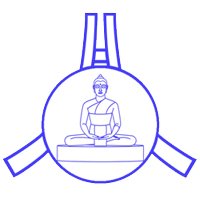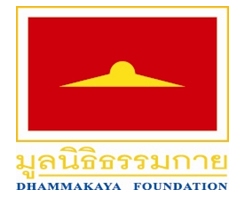The Dhammakaya Temple
One dream for the inner peace of millionsFrom nothing… to a large tract of land
From a large desolate field… to a graceful Buddhist temple
From one monk… to tens, to hundreds, to thousands and counting
From a hundred followers… to thousands, ten thousands, hundred thousands, and millions in the future
The land that is now Wat Phra Dhammakaya was once a large rice field, stretching as far as the eyes could see. The water glistened with the rays from the hot sun with not a single tree or building to shade the heat, and the nights were lit only by the stars.
The 77 acres was donated by Lady Prayad Pattayapongsavisuttatibodi to celebrate her birthday. On Magha Puja Day, February 20, 2513 B.E., Luang Por Dhammajayo, Master Nun Chand Khonnokyoong (61 years old at the time), and their followers came together to begin the construction of a meditation center. The meditation center then became Wat Phra Dhammakaya on April 29, 2524 B.E.
With only 3,200 baht as the budget, the followers felt as if they were building the meditation centre with their bare hands, so they expressed doubt to the Master Nun, to which she asked back, “What is the cost of raising just one truly good person with morals and dedication to Buddhism?” The follower replied, “If you spent 100 million, there may be a small chance to get one that good…” So, the Master Nun said,“I have 11 truly good people sitting in front of me today, so I now have at least 1,000 million baht in budget. I will build this place.”
The meditation center was built along with meditation teaching. More and more followers searching for peace and happiness came to learn meditation with the Master Nun and Luang Por Dhammajayo. They donated money after meditating and finding true happiness within themselves, so the temple received more and more monetary support from every follower that it was successfully built.
After the temple was established, more and more people came to learn the Dhamma of the Lord Buddha and practice meditation. From hundreds of people, to thousands, to ten thousands in 2527 B.E., the 77 acres became too small to accommodate everyone seeking to meditate at the temple. Thus, it was necessary to acquire and develop additional plots of land and to extend the infrastructure to serve the congregation. Every building at Wat Phra Dhammakaya was designed to be simple, strong and non-luxurious while saving costs of construction and maintenance in order to maximize the benefits of usage in promoting peace and harmony to humankind.
Every atom of this land, every building, every ceremonies, and everything good that has happened inside this temple is not any one person’s achievement. It is the collective achievement of the monks, novices, and devotees who fought against the odds together time in time out. Especially, the group of people from the beginning who must have great faith, determination, and patience in order to transform a dream of a temple into an actually sanctuary, the Dhammakaya Temple, that we can now see today.
Wat Phra Dhammakaya

Wat Phra Dhammakaya was built according to the four factors that contribute to the cultivation and development of virtues that were taught by the Lord Buddha. These include:
- Pleasant location
- Pleasant food
- Pleasant people
- Pleasant Dhamma
With the concept “building a true temple, training true monks and promoting people to be truly virtuous.”
Though the temple is located in the middle of an urban city, within our walls, it is peaceful and accommodating to everyone looking to find true inner peace. The temple is kept clean by everyone who lives inside, so the cleanliness from the environment may aid the purifying of the mind.
The monks who ordain at the Dhammakaya Temple have orderly and simple quarters. In the original 77 acres of the temple, has an area partitioned as a monks residence. It is serene and peaceful with a forest atmosphere. The monks’ residence are little cottages large enough for meditation, sleep, and storage of very few necessities, and small enough to avoid being luxurious in any way. Thus, the monks may dedicate their time to their studies of Buddhist Scriptures and to practice meditation without any distractions.
The kitchen at the temple was built and maintained to feed everyone who comes to the temple in order to learn about Buddhism and search for inner peace, so that at the very least no one has to worry about starving at this temple. The Master Nun had an intention that have passed on to all of her students at the temple that “If 100 people came to the temple, we will feed 100 people. If one million people came, we will feed one million people.”
Without worries and distractions in the mind, everyone at the Dhammakaya Temple may cultivate inner peace and learn Dhamma of the Lord Buddha.
Dhammakaya Foundation

The extension of the Dhammakaya Temple, which is 791 acres, was acquired in the name of the Dhammakaya Foundation, using the funds from followers who donated to the temple to expand the temple’s public area. This new public area’s purpose was to provide a peaceful sanctuary to facilitate meditation teachings, Buddhist events, and monastic ceremonies.
The extended land has been used for the propagation of Buddhism since the year 2528 B.E. By the year 2542 B.E., over 100,000 people came to attend each special Buddhist ceremonies. Today, the number is still growing rapidly, and the Sapa Dhammakaya, which once seemed large, often became even too small for many events.
The Dhammakaya Foundation has used the 791 acres for many public and peace events. For example, mass ordination programs, meditation retreats, youth moral festivals, Light of Peace ceremonies, and many more each year. The facilities can house up to 1,000,000 people each event, so it has been a very beneficial facility used for local gatherings, international gatherings, and peace advocacy events.
Since August 1986 the Dhammakaya Foundation has become the United Nations-accredited Non-Governmental Organisation associated with the Departmen Public information (DPI) and has since that date sent delegates to the Annual DPI/NGO Conference of the United Nations.
In February 1999 the Dhammakaya Foundation has been participating in the Millennium People’s Assembly Network called for by the United Nations Secretary General. Kofi Annan.
On Earth day 22 April 1999 the Dhammakaya Foundation supported the promotion of 2000 International Year for the Culture of Peace which is proclaimed by the General Assembly of the United Nations. A hundred thousand Buddhist monks and novices have participated the ethic contest organised for support the culture of peace educational programme. On the same occasion, thousands of temple followers have signed the Commitment for Culture of Peace. The Commitment is drafted by a group of Nobel Peace Prize Laureates which UNESCO is the focal point, and in response to an appeal signed by all the Nobel Peace Laureates -the first decade of the next millennium -the years 2001-2010 -as the “International Decade for a Culture of Peace and Non-Violence for the Children of the World”.
The Dhammakaya Foundation has also demonstrated an co-operative participation in the seventy-two hours Interfaith Peace Building Project of the United Religions initiative in order to play an important role as a living pledge to a new and more hopeful future for all people. The programme will be held on from 31 December 1999 to 2 January 2000.Hundred thousand of people will participate in meditation and illuminate the Light of Peace of the Millennium.
During May 11-15, 1999, the Dhammakaya Foundation has sent 13 representatives to participate the Hague Appeal for Peace Conference, which is the largest international peace conference in history. Over 9,000 activists, government representatives and community leaders from over 100 countries attended the conference workshops and round tables mechanisms for abolishing war and creating a culture of peace in the 21st century. The Dhammakaya Foundation also organized 3 sessions of Global Meetings on Meditation to provide interested participants in seeking the real peace from within.














